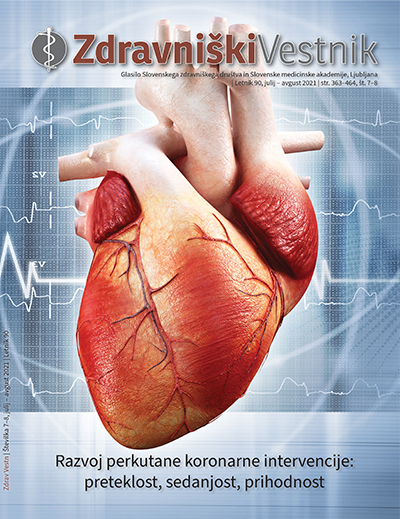Evaluation of patient-related administrative burden regarding non-emergency control referrals for family physicians in Slovenia
DOI:
https://doi.org/10.6016/ZdravVestn.3043Keywords:
family practice, workload, time management, administrative efficiency, financial managementAbstract
Background: Non-emergency control referrals are often ordered by a clinical specialist. A control referral demands that a family physician carries out an administrative task to further extend the validity period after its validity period has expired. With the administrative burden on family physicians increasing in today’s healthcare system, the additional “gate-keeper” role of family physicians in repeated issuing of non-emergency control referrals seems redundant. The aim of this study was to evaluate administrative burden regarding the time consumed and money billed for prescribing non-emergency control referrals, and to present a more efficient model for prescribing non-emergency control referrals.
Methods: We designed a cross-sectional quantitative study. By means of automatic statistical data collection with IRIS software, we gathered statistical information regarding control referrals and overall completed tasks in nine selected family physicians’ offices in the “Center” unit of the Ljubljana Community Health Centre, in the time period from 1 March 2018 until 30 June 2018.
Results: Altogether, 7340 referrals were analyzed. Control referrals accounted for 37% (2720 referrals) of all referrals or 75 referrals monthly per GP’s office. The majority of these (90% or 2453 referrals) were for a non-emergency case. As many as 86% (2104 referrals) of non-emergency control referrals were prescribed without a physical examination. A family physician spent on average 68 minutes per week or 3.5% of his or her work time issuing such non-urgent referrals. This time is equivalent to a measured time of ten average visits to the family physician’s office. For issuing non-emergency control referrals, a family physician’s office bills on average €255€ monthly or 6% of all billed services. This accounts to €203,191 monthly for all family physicians in Slovenia and a monthly time load of 2.8% working time.
Conclusion: The administrative burden of issuing non-urgent control referrals is both time- and money-consuming while being apparently unnecessary. We present a new model for issuing control referrals that eliminates unnecessary administrative burden and enables a more systematic pathway for referrals in cases of acute chronic disease exacerbation.
Downloads
References
1. Kersnik J, Švab I. Evropska definicija družinske medicine. Ljubljana: Združenje zdravnikov družinske medicine; 2004. pp. 5-7.
2. Zdravniška zbornica Slovenije in Slovensko zdravniško društvo odgovorne pozivata k administrativni razbremenitvi zdravnikov v osnovnem zdravstvu. Ljubljana: Zdravniška zbornica; 2018 [cited 2018 Dec 21]. Available from: https://www.zdravniskazbornica.si/informacije-publikacije-in-analize/obvestila/2018/12/21/zdravni%C5%A1ka-zbornica-slovenije-in-slovensko-zdravni%C5%A1ko-dru%C5%A1tvo-odgovorne-pozivata-k-administrativni-razbremenitvi-zdravnikov-v-osnovnem-zdravstvu.
3. Švab I, Petek Šter M, Kersnik J, Živčec Kalan G, Car J. Presečna študija o delu zdravnikov splošne medicine v Sloveniji. Zdrav Var. 2005;44:183-92.
4. Govc-Eržen J, Selič-Amon M, Žmavc A, Veninšek-Kajba S, Rajtmajer M, Kolar M. Koliko časa porabi zdravnik splošne medicine za administrativna opravila. Zdrav Var. 2004;43:111-6.
5. Živčec Kalan G, Petek Šter M, Kersnik J. Determinants of family physicians’ workload. Zdrav Vestn. 2012;81:461-9.
6. Rao SK, Kimball AB, Lehrhoff SR, Hidrue MK, Colton DG, Ferris TG. The Impact of Administrative Burden on Academic Physicians: Results of a Hospital-Wide Physician Survey. Acad Med. 2017;92:237-43.
DOI: 10.1097/ACM.0000000000001461
PMID: 28121687
7. Thun S, Halsteinli V, Løvseth L. A study of unreasonable illegitimate tasks, administrative tasks, and sickness presenteeism amongst Norwegian physicians: an everyday struggle? BMC Health Serv Res. 2018;18(1):407-16.
DOI: 10.1186/s12913-018-3229-0
PMID: 29871623
8. Tyssen R, Palmer KS, Solberg IB, Voltmer E, Frank E. Physicians’ perceptions of quality of care, professional autonomy, and job satisfaction in Canada, Norway, and the United States. BMC Health Serv Res. 2013;13(1):516-62.
DOI: 10.1186/1472-6963-13-516
PMID: 24330820
9. Razpad sistema: odpovedi podalo 23 kranjskih splošnih zdravnikov. Ljubljana: RTV Slo; 2019. Available from: https://www.rtvslo.si/zdravje/novice/razpad-sistema-odpovedi-podalo-23-kranjskih-splosnih-zdravnikov/484233/.
10. Soler JK, Yaman H, Esteva M, Dobbs F, Asenova RS, Katic M, et al. Burnout in European family doctors: the EGPRN study. Fam Pract. 2008;25(4):245-65.
DOI: 10.1093/fampra/cmn038
PMID: 18622012
11. Vajd R, Kersnik J, Turk H. Napotitve zdravnika družinske medicine na sekundarno raven. In: Turk H, Kersnik J. Napotitve zdravnika družinske medicine na sekundarno raven. In: VII. Kokaljevi dnevi. Zbornik predavanj>. 2007 Apr 12-14; Kranjska Gora, Slovenija. Ljubljana: Združenje zdravnikov družinske medicine; 2007.
12. Boerma W, Van Der Zee J, Fleming D. Service profiles of general practitioners in Europe. European GP Task Profile Study. Br J Gen Pract. 1997;47(421):481-6.
PMID: 9302786
13. Forrest CB. Primary care in the United States: primary care gatekeeping and referrals: effective filter or failed experiment? BMJ. 2003;326(7391):692-5.
DOI: 10.1136/bmj.326.7391.692
PMID: 12663407
14. Groenewegen P, Van Der Zee J. The comparison of health care systems throught reginal analysis: the case of hospital admissions in Belgium and the Netherlands. Soc Sci Med. 1988;26(1):91-100.
DOI: 10.1016/0277-9536(88)90048-2
PMID: 3353758
15. Kalan Živčec G. Model za ocenjevanje obremenitev z delom zdravnikov družinske medicine v Sloveniji [PhD Thesis]. Ljubljana: Kalan živčec G; 2019.
16. Živčec Kalan G, Skačej H. Kako zmanjšati število napotitev in izboljšati njihovo kakovost. Med Razgl. 2005;44:479-87.
Downloads
Published
Issue
Section
License

The Author transfers to the Publisher (Slovenian Medical Association) all economic copyrights following form Article 22 of the Slovene Copyright and Related Rights Act (ZASP), including the right of reproduction, the right of distribution, the rental right, the right of public performance, the right of public transmission, the right of public communication by means of phonograms and videograms, the right of public presentation, the right of broadcasting, the right of rebroadcasting, the right of secondary broadcasting, the right of communication to the public, the right of transformation, the right of audiovisual adaptation and all other rights of the author according to ZASP.
The aforementioned rights are transferred non-exclusively, for an unlimited number of editions, for the term of the statutory
The Author can make use of his work himself or transfer subjective rights to others only after 3 months from date of first publishing in the journal Zdravniški vestnik/Slovenian Medical Journal.
The Publisher (Slovenian Medical Association) has the right to transfer the rights of acquired parties without explicit consent of the Author.
The Author consents that the Article be published under the Creative Commons BY-NC 4.0 (attribution-non-commercial) or comparable licence.



